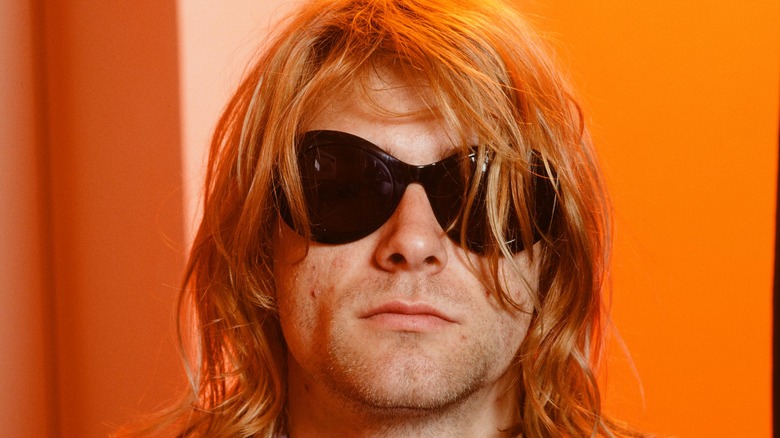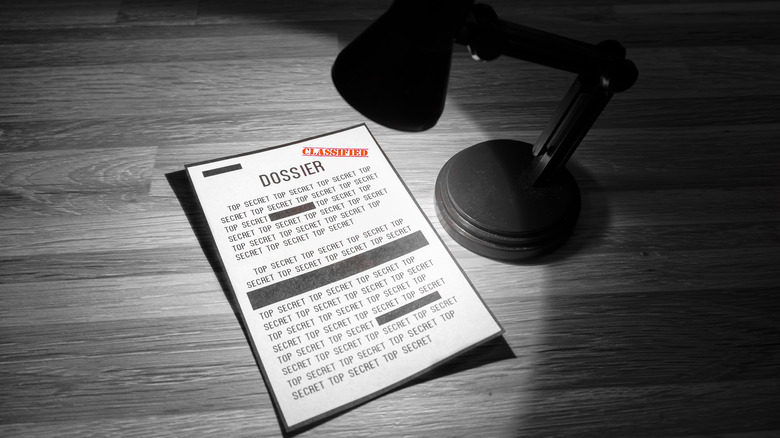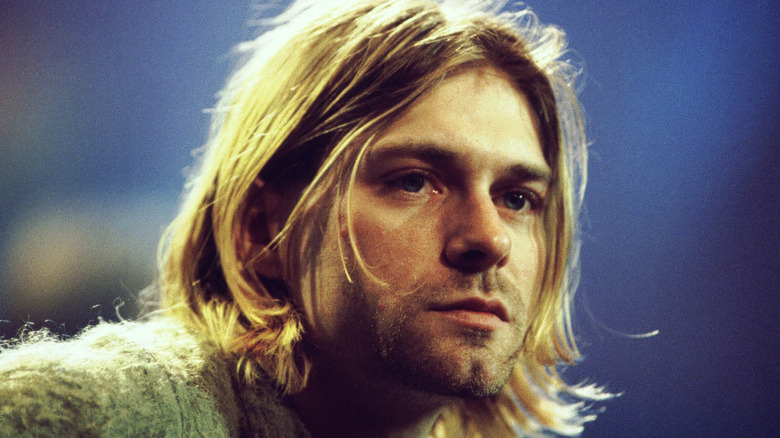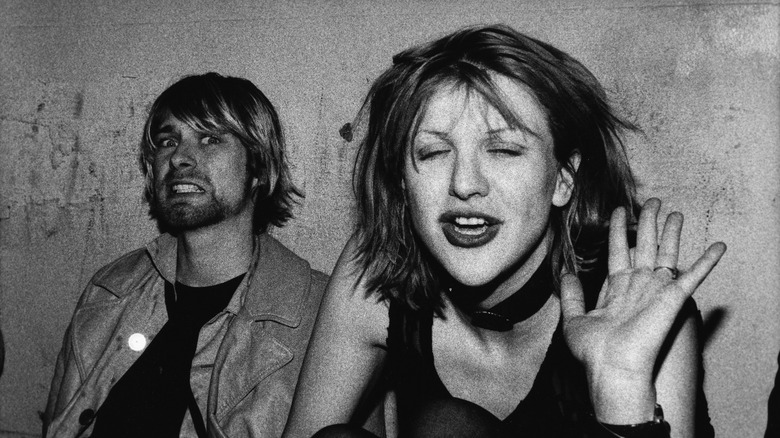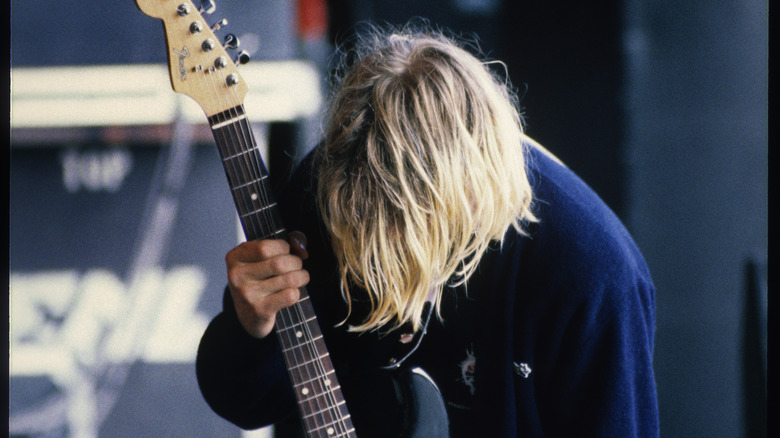What's Inside The Newly Released Kurt Cobain FBI File
It's been over 27 years since singer-songwriter and Nirvana frontman Kurt Cobain died from what authorities called a self-inflicted gunshot wound. There have always been fringe theories floating around that Cobain was actually murdered rather than dying from suicide. The documentary filmmaker Nick Broomfield even made an entire movie (1998's "Kurt & Courtney") about the "murder theories" surrounding Cobain's death, including those that suggested Cobain's widow, Courtney Love, was somehow involved. Well, it looks like the FBI has been quietly keeping a file concerning this very topic.
In April of 2021, as reported by Rolling Stone, the Bureau made public its 10-page-long file on Cobain's death with no commentary as to why they were doing so. The contents include two letters with the names of their writers redacted, both of which urge the FBI to investigate Cobain's death as a murder rather than a suicide. One letter from September 2003 includes the line, "Millions of fans around the world would like to see the inconsistencies surrounding his death cleared up once and for all," and references Broomfield's documentary.
'His killer is still out there'
The second letter is handwritten and dates to 2007. It includes lines such as "his killer is still out there," supposed evidence such as "there were no prints on the gun he supposedly shot himself with," and claims that Cobain's suicide note contains handwriting from two different people. The FBI responded to both letters with nearly identical form letters explaining that homicide investigations generally fall under the purview of local and state authorities unless they involve violations of federal laws, which Kurt Cobain's case did not.
The file also included a similar letter with redacted personal information originally intended for then-Attorney General Janet Reno. Another odd addition to the file was a fax detailing various conspiracy theories about the case that had been sent to FBI offices as well as several executives at the NBC television network from someone at Cosgrove/Meurer Productions, which is the company that produces the NBC series "Unsolved Mysteries." The show did an episode on Kurt Cobain conspiracy theories in 2008, and a representative from "Unsolved Mysteries" told Rolling Stone that they are in "constant contact" with the FBI, as they are continually trying to get information on various cases.
No truly shocking revelations came from the FBI file and it's still unclear why the Bureau decided to release it when they did. However, a look into the investigation that inspired those letters reveals some questionable facts about Cobain's supposed suicide.
Courtney Love's private investigator questions the suicide theory, as well
In addition to Broomfield's film, the letters to the FBI also reference an investigation carried out by a man named Tom Grant, a private eye hired by Courtney Love in the days just before Cobain's death. On his website CobainCase.com, Grant writes that his months-long investigation led him to "the conclusion that Courtney Love and Michael Dewitt, (the male nanny who lived at the Cobain residence), were involved in a conspiracy that resulted in the murder of Kurt Cobain."
Grant says Love hired him in April 1994 to find Kurt Cobain after he left a rehab clinic located in Marina Del Rey, California. So he and Dylan Carlson, Cobain's best friend, flew to Seattle to look for the troubled Nirvana frontman. The day after they searched his home unsuccessfully, Cobain's body was found dead in the room located above the garage, an apparent suicide. But Grant wasn't buying it. Even Courtney Love's lawyer and close friend to the couple, Rosemary Carroll, had her suspicions. "We both knew," writes Grant, "something was terribly wrong here." So just what did Grant's investigation dig up? Let's take a look into his theory that Kurt Cobain was murdered and see.
Tom Grant's investigation into Kurt Cobain's death
While the horrendous spelling and grammatical errors in one of the notes to the FBI may cause some to attribute the claims of conspiracy to a wacko, the facts of Grant's investigation shouldn't be neglected simply because the note's author could have used a proofreader. A sober look into what Grant found leads one to some legitimate questions about what happened in that room on April 5, 1994.
The conclusions Grant outlines on his website are also the subject of his 2015 documentary "Soaked In Bleach," and while they start out as seemingly circumstantial and unconvincing, they end up being rather difficult to ignore. He starts off by noting how Kurt and Courtney were in the process of getting divorced, and that Love stood to lose a considerable amount of wealth as a result. Grant also found that someone had Cobain's credit card after he died and attempted to use it up until the news that his body was discovered began to make headlines. Again, these facts are a little fishy, but definitely don't point unequivocally to murder. But let's keep digging.
The details surrounding Kurt Cobain's death don't add up
Grant's investigation into Kurt Cobain's so-called suicide continue to arouse suspicion. He found several details that differ from the official story that Cobain was just a messed-up junkie who killed himself. For example, the media reported that Kurt bought the shotgun that ended his life after he left that rehab center, but that is not true. In "Soaked In Bleach," Grant notes how Cobain and his housemates bought the firearm after an attempted break-in at their house. The shotgun also brings up questions about the Seattle police department's investigation into the incident. Their official story is that there were no legible fingerprints to be found on it, but Grant discovered that they didn't even check the thing for prints until almost a month after Kurt's body was found.
Grant also questions the idea that the singer left behind a suicide note. He points out how it never mentions suicide and is more of an angst-riddled farewell to the music industry than a goodbye-cruel-world kind of letter. Grant also notes that the only lines written to those most important to Kurt — Courtney and his daughter Frances — are tacked on as a post-script afterthought, and appear to have been written by a different hand from the rest of the note. The full text, scanned letter, and theories behind it can be found at KurtCobainSuicideNote.com.
The undeniable evidence in the case for Kurt Cobain's murder
Up to this point, the results of Grant's investigation remain circumstantial. Questionable and mysterious, yes, but nothing like a smoking gun. However, Grant points to one undeniable fact in the case that cannot be overlooked. The toxicology report revealed that the amount of heroin in Cobain's body at the time of his death was three times that of a lethal dose. Even an addict who had built up a tolerance to the drug, as we can assume Cobain had, would have not survived such a large dose. This leads to the obvious question: if Kurt Cobain had three times the lethal dose of heroin in his system, how did he manage to shoot himself? Also, why would he need the shotgun if he'd already taken enough heroin to do the job? As Grant concludes, it would have been impossible for Kurt Cobain to shoot himself after injecting that much heroin into his body.
The newly released FBI files on Kurt Cobain reveal that others are also unconvinced that the grunge singer killed himself. However, as Page Six notes, the feds assert that the case does not fall under their jurisdiction. But who knows, maybe now that the FBI has released its files on the Cobain case, new light will shine on his death and what some believe to be the truth may finally be revealed.
